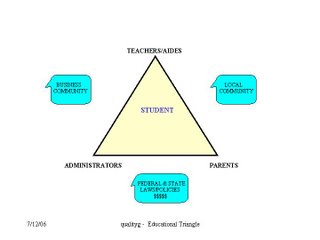Let me explain…
First we need to set up a scenario. Let’s say in our state we have one million students in grades 4-16 and our state test scores indicate we have 85% percent of our students (Majority) who have a Grade Point Average (GPA) of a C (2.0 out of 4.0) or better. That leaves 15% of our students who receive a D or below (Minority). Also included in the Minority group are school dropouts. Special Needs Children are in a separate study and not included in these figures.
The breakdown of numbers is 850,000 are passing and 150,000 are failing. Failing in this scenario does not mean being left behind in a grade or not passing a class, it just means below average.
I think most of us would agree that 150,000 students not learning is not acceptable. What if we had the same figures in nine other states that would mean 1.5 million students? Ouch!
This scenario makes perfect sense to me because what else should we expect when we teach only to the Majority? The foundation of our teaching methods is based upon what I call “basic reactive receiving” of information. I give you information, you remember information and I test you with feedback fill in the blank, multiple choice and true and false questions to see if you remember information. Does remembering = learning? Does learning = knowledge?
I’m not blaming teachers and I’m not blaming the curriculum. The foundation and environment that establishes our educational is flawed and has been for a long long time. The current approach “basic reactive receiving” serves the majority well, but is well good enough?
Charles Darwin said it is not the strong or even the smart that survive; it is the most flexible. There is the key word “FLEXIBLE.”
The following questions may help put some things in perspective:
- Why do students learn best when there is interaction with their teacher and or other students?
- Does interaction mean doing, instead of just basic reactive receiving?
- Why can’t there be enough experienced trained teachers to be able to teach in a regular sized classroom, plus a room for those who learn in smaller settings and for those who need one-to-one assistance (we do it for special ed, are there not regular ed that need this type of assistance?
- How much does self-esteem come in to play in order for a student to learn?
- Does that mean we all have to hit a jump shot to make the team of learning?
- I have been learning a lot working with Autistic and Asperger children when it comes to sensory integration. So why do we primarily utilize a few senses (see & hear)and not all of them including “common"?
- Is it not important to tailor fit approaches for both analytical (i.e., critical thinking, problem solving and innovation) and reflective (i.e., motivation, self- esteem) learning as well as basic reactive learning?
Are we sub-optimizing our student’s potential only using parts of our brain? Just think what knowledge our children could be learning if they could optimize their whole brain, and it would be fun, it would be “Joy of Learning (Deming)”.
I can hear some folks now “So what is new” and “Dream on qualityg dream on…”
BABY BOOMERS TO THE RESCUE
BABY BOOMERS TO THE RESCUE
We know that every student does not learn in the same manner so why do we continue to teach in the same type of environment and teaching methods. Is it the lack of dollars to have smaller classroom sizes? Is it the lack of knowledgeable and experienced teachers (knowledgeable and experienced do not mean “Certified”)?
I believe we have untapped gold mine that can help with many of the questions I asked above. It is the Baby Boomers who are looking for competent and meaningful work after they retire or take early buy outs. Many Baby Boomers are experienced and educated and would make a great resource to bolster the teacher to student ratio.
Now all you “Certified” teachers out there don’t get in a tizzy and go into a protective mode. I am suggesting Baby Boomers to be Aides and Teacher Assistants. Create a new position that will pay a decent rate. These types of Retired Baby Boomers are not looking for monetary gains or security, they are still looking to make a difference and find purpose for getting up in the morning.
We need to take monies slotted for other programs (not just in education) like individualized per student spending and create one pot to hire these new assistants. If children are our future then government and business needs to step up and prioritize dollars to education and quit cutting funds as soon as things get tough in the economy (again sub-optimization).
The following diagram ( Click on PIC to Enlarge) explains what I am saying, we are all in this together and there has to be a balance (optimization), for one group to go it alone is disaster (sub-optimization).
If you want proof look at the few teachers that are considered the best by your children. I bet it is the ones who inspire and encourage each student by utilizing all of their talents; the one’s who can take a large class and make each student feel important.
Want more proof? I am an example, I retired early, I am back in school, I am working in an elementary school, I feel good and I am making a difference.
I know there are good teachers who cannot or do not have these qualities, so let us give them some additional support.



No comments:
Post a Comment